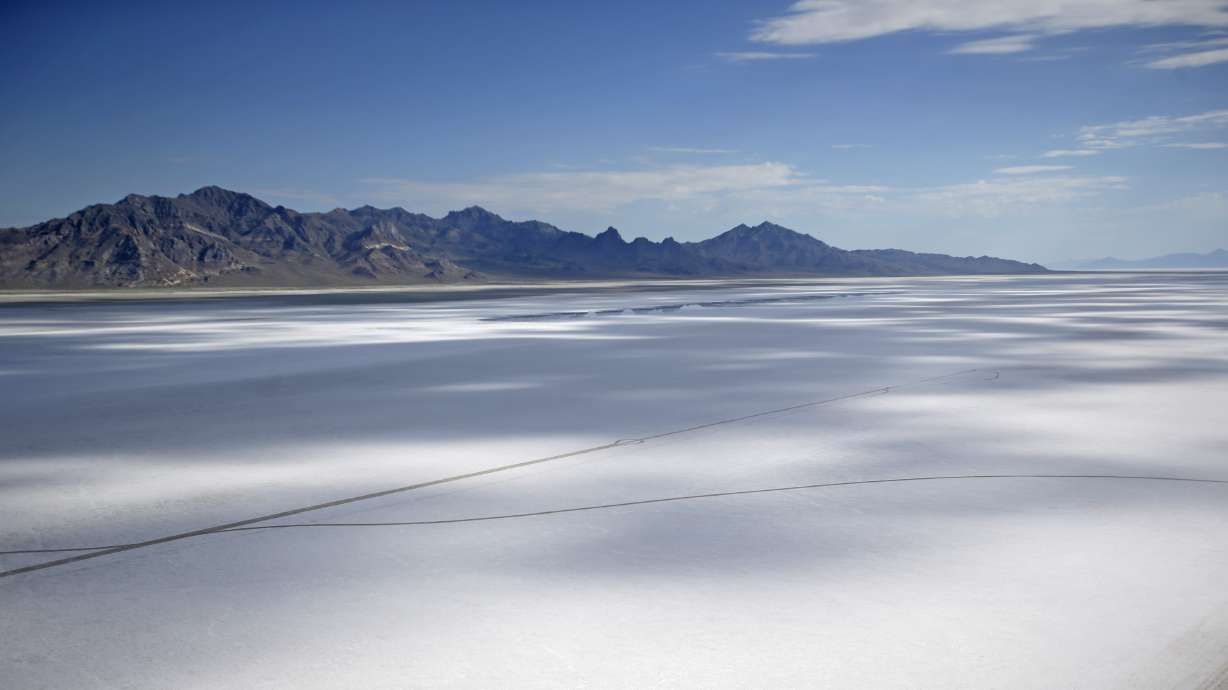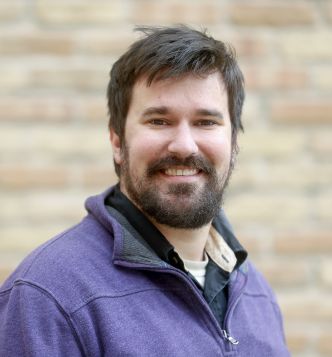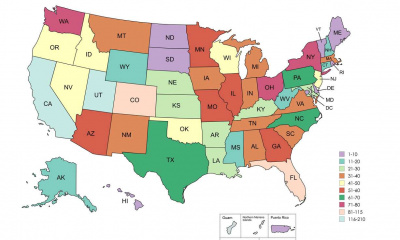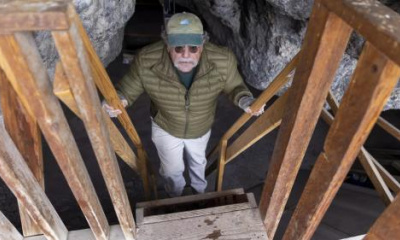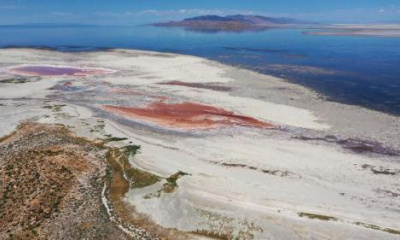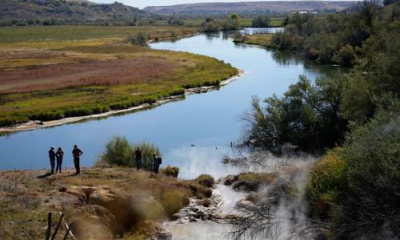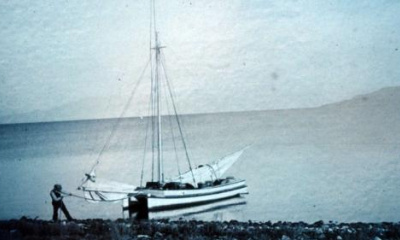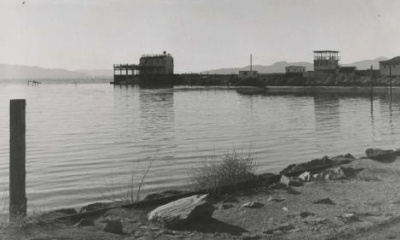SALT LAKE CITY — Daron Duke is captivated by an image he's projected on a screen he's shared with curious archaeologists and prehistoric aficionados.
It's a pair of pictures in northwest Utah: Blue Lake, south of Wendover by the Utah-Nevada border, and the desert surrounding it. One is a relatively small wetland while the other looks like it could be from the surface of the moon. This, he says, essentially captures the vast difference of some 10,000 years in what is Utah's West Desert today, although it's difficult to really picture the kind of place the West Desert once was.
"Imagine more plants, more cattails, bulrush (and) willow sprawled all over the entirety of it," Duke, a Nevada-based principal for the Far Western Anthropological Research Group, said during an online event hosted by the Utah State Historic Preservation Office on Wednesday.
As the second photo demonstrates, the entire West Desert is now about the exact opposite of what the area once was. The planet warmed as it left the Pleistocene era and Lake Bonneville receded to what is now the Great Salt Lake. And as the Great Salt Lake now dries to the lowest level in its recorded history, there's plenty more moonscape to go around.
While many conservation experts, lawmakers and others focus on the Great Salt Lake's decline, Duke continues to research the "lost oasis" that is the West Desert. His studies offer clues that help historians understand what the area was once like and how it was used at the end of the Pleistocene, which is about the same period of time where human activity in modern-day Utah begins.
A prehistoric wetland
Most of what is considered the Great Basin today is massive — stretching through most areas west of the Rocky Mountain and east of the Sierra-Nevada mountain ranges — reaching as far south as the Mojave Desert and as north as present-day Oregon. These areas are mostly desert now but once were a massive series of thriving lakes, rivers and wetlands.
The portion near the old Lake Bonneville was no exception. When the prehistoric lake began to recede about 14,000 or 15,000 years ago, there was still plenty of water left behind to make it a productive area to live, because temperatures were cool enough that water didn't really evaporate as much as does today.
"For the nothingness it is now, the contrast is that it wouldn't only have been an attractive wetland for people and animals and everything else — just life in general, it would have been the biggest one in the entire Great Basin and entire desert (space in the) West," Duke said. "It's creating a freshwater wetland and it looks like that's what really began attracting people."
It's why he isn't surprised — even if it's possibly from coincidence — that some of the earlier evidence of human life in Utah, which dates as far back as at least 13,000 years ago, is found in the northwest corner of the state.
The artifacts include Clovis points and other items that appear to be related to hunting tools, even if that's still more of a theory. One artifact found in the West Desert was even found to have elephant antiserum, which Duke says, would indicate mammoths once roamed the land — and were probably hunted by the earliest human inhabitants.
His work, however, centers on what's known as the Wishbone Site located on U.S. Air Force land about 30 miles south of Interstate 80 in Tooele County. The barren landscape is close to what would have been the edge of the wetlands in the past.
Archaeologists were drawn to the site after finding charcoal and fragments of waterfowl bone eroded out of the ground about a decade ago. It was a unique find because the mixture of wind, salty land and moisture underneath the desert can quickly destroy prehistoric evidence; however, it can also preserve the past when the conditions are right.
The artifacts collected turned out to be burnt willow wood, as well as bones, waterfowl gastroliths, fragments of prehistoric tools and tobacco seeds dating back 12,300 years ago. The latter of those finds appears to have been grown on the land when it was possible to do so; it is also the earliest known human use of tobacco in all of North and South America.
All of these help archaeologists piece together how the land was used thousands of years ago when it was habitable.
"It just gives you some insight to the people — I mean this is a campfire scene we're getting here (with) all the little pieces of what's going on out here," Duke explains. "(It's) a fireside activity, eating ducks ... and then enjoying tobacco."
Subsequent studies of the area have helped determine the various plants that once grew on the land, like red maids and pitseed goosefoot. Archaeologists plan to dig at another site in the area in the near future, too.
But the prehistoric window experts have found in the West Desert is only about 3,000 years and closes 10,000 years ago. The humans' hunting tools seem to shrink over that span, too, indicating the animals humans were hunting had died off. The end of the window is also about the same time scientists believe megafauna became extinct.
What happened to the oasis?
The end of the Pleistocene era came as Earth began to shift into a warming period known as the Holocene epoch. Duke refers to this as "Global Warming 1.0," essentially, as the era drastically shifted the climate of the region. The Great Basin slowly and surely became a desert with little to no evidence that it was once a thriving wetland.
This led to a change in human behavior, too. What started as "high mobility" led to a more "localized" civilization, Duke says.
This is evident in the range of obsidian-based prehistoric tools. The range of the oldest obsidian tools is all over the West, from near present-day Beaver in southern Utah, to northeast Idaho and as west as northern Nevada. The range shrinks for similar tools dating back 9,000 years ago, which are primarily found in areas closest to where the original obsidian source is in Utah.
"We have this to tell us a big dynamic is going on. As you leave the ice age ... things kind of start drying up on them in other areas of the Great Basin," Duke said. "They went from long, mobile ranges and probably a much sparser population on the landscape. ... It's like the faucet went off out here and people changed."
Artifacts in Utah indicate people started shifting away from the wetlands and moved to the highlands, like Danger Cave near Wendover. New innovations, like grinding pickleweed seeds, appear as the drying of the old wetlands continues.
This change is also when artifacts of life closer to Utah Lake begin to pick up. It's one of the places where people and animals migrated.
Elizabeth Hora, an archeologist for the Utah State Historic Preservation Office, in March presented her findings of the region where freshwater remained, referring to its wetlands as a "prehistoric grocery store." Her research of artifacts also indicates people became even more localized as the Great Basin dried up further.
Relevance today?
The Great Basin region only continues to dry up with the 20-year Western megadrought, which is considered the worst in 1,200 years. It has caused the Great Salt Lake and other Western bodies of water to dry up at alarming rates, as global temperatures reach new record highs.
It matters in a desert when your water goes away. It mattered to these folks in the past and it matters now.
–Daron Duke, principal for the Far Western Anthropological Research Group
Does this make the end of the West Desert wetlands more relevant today?
It's difficult to understand the human connection of prehistoric human life to modern times because there were fewer people with vastly different lifestyles living thousands of years ago, Hora said. On top of that, most of what's known of prehistoric life is the result of piecing together fragments of the past, so it's impossible to know how it really changed human thinking.
Yet the story of the lost oasis does seem to show a connection to patterns today, in the sense that humans and animals follow the water. Its availability and scarcity change behaviors and lifestyles, leading to adaptation and innovation.
It still remains to be seen what the final impact of the ongoing megadrought is, other than it's already changing the ways people consume water in the West and by the Great Salt Lake.
"It matters in a desert when your water goes away," Duke says. "It mattered to these folks in the past and it matters now. They couldn't stop it. Can we? I don't know."

